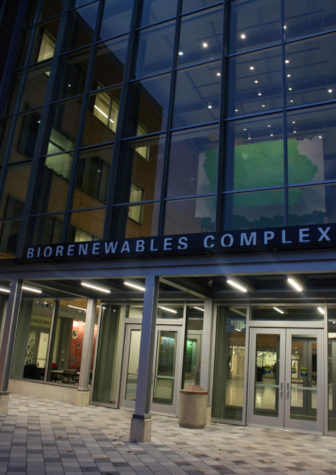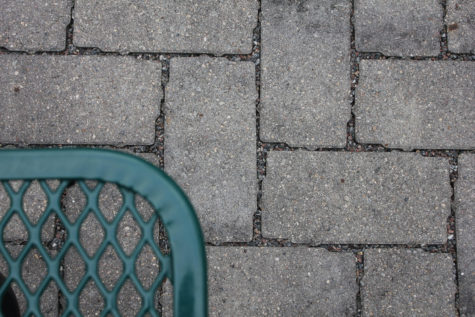Energy in Ames: More than just electricity
April 20, 2012
Iowa State Power Plant
The production of electricity has a long history at Iowa State, beginning with the first electric lights being sent to the university from Thomas Edison in 1880. Since then Iowa State has made great strides in electricity use, building its first power plant in 1891 and a new, updated plant in 1906. This plant used steam as a source of electricity and heating, which laid the foundation for Iowa State’s use of cogeneration. Since that time, the plant has been expanded and modified to meet the university’s growing energy needs and to ensure compliance with increasing environmental requirements.
Cogeneration produces heat and electricity at the same time by burning coal to create steam, which spins turbines to generate electricity for the university. The steam is then reused, being sent to university buildings for heating during the colder months. When the weather is warmer the steam is sent to one of four chillers to cool water, which is sent to campus through underground piping to absorb heat from buildings. The water then returns to the power plant, is cooled again, and cycles back to campus.
By utilizing this process the power plant has a thermal efficiency of around 55 percent, as opposed to the 35 to 42 percent usually seen with power plants not using cogeneration. Because this process results in higher efficiency, using cogeneration also reduces the amount of nitrogen oxide, sulfur oxide and carbon dioxide emitted into the air due to the decreased amount of fuel burned to create power.
“We have a staff here who wants to run this plant as efficiently as we can,” said Jeff Witt, director of utilities for the 75 member staff that works 24 hours a day to keep Iowa State powered. In attempt to keep the power plant running as efficiently as possible, the staff has come up with many ways to keep the carbon footprint of the plant to a minimum.
The plant contains five different boilers and runs two, three or four boilers depending on the campus energy demand. The primary boilers are two fluidized bed boilers that burn coal and limestone together. The limestone removes more than 90 percent of the sulfur that is in the coal. All boilers are equipped with pollution control equipment that captures the ash from the coal. The newest equipment collects 99.5 percent of the ash while the older equipment collects 97 percent of the ash. Because of the efficiency of this equipment, there is no smoke emitted from the plant smoke stacks.
The oldest boiler is not as efficient, only collecting 92 percent of the ash so this boiler is seldom operated. The ash that is collected is taken to a limestone quarry for reclamation of the quarry and eventually is covered with topsoil and turned into farmland. The groundwater in the quarry is monitored now that chemicals are polluting it.
The power plant is also experimenting with the burning of wood chips along with coal. The use of wood would reduce the amount of coal burned. The wood has no sulfur which reduces sulfur emissions but other emissions, such as nitrogen oxide, will increase. The problem with burning wood, however, is that it has less energy content and costs more than coal.
While the staff at the power plant works hard to keep Iowa State’s carbon footprint low, Witt stresses that, while they manage the energy source, they have little control over energy demand. It is important that students be mindful of how much energy they use in order to keep Iowa State as green as possible.
Resource Recovery Center
The average person throws away 3.7 pounds of municipal solid waste a day. In most cities, that waste ends up taking hundreds of years to decompose in vast landfills. Not Ames. In 1974, construction began to build the first waste-to-energy plant in the United States.
Rather than the traditional methods of sorting municipal solid waste from recyclables, Ames citizens need only one trash can in which to put all their waste. Exceptions to this are hazardous waste and glass. Hazardous wastes (such as cleaning chemicals or propane tanks) can be dropped off for free at the resource Recovery Center for disposal every Wednesday afternoon. Glass wears down the the machines when it is broken down. Therefore, yellow glass-recycling trash bins are located outside a variety of grocery stores around Ames and near some ISU residence halls.
The municipal solid waste, however, is transported to the Resource Recovery Center where it is sent through a primary shredder to break the waste down into smaller pieces. Metals are then separated from the mix by special magnets in order to be recycled. The waste is then sent through a secondary shredder to break it down even further. Next, an air knife is used to separate the waste that will be sent to the Ames Power Plant for Refuse Derived Fuel, the left over material is sent to the Boone County Landfill. In the end, 70 percent of the municipal solid waste sent to the Resource Recovery Center is used for energy or recycled.
In order to have the Resource Recovery Center in place, residents of Ames currently pay a per capita fee of $9.10 through their property taxes annually. According to Lorrie Hanson, secretary of the Resource Recovery Center, this price does fluctuate but has never risen higher than $17. A small fee compared to the savings in electricity costs residents receive annually. Compared with landfills, waste-to-energy plants do a lot of good for the environment and the community too. For instance, waste from landfills can leach into the ground and pollute valuable ground water and aquifers. The organic waste in landfills also gives off methane gas which contributes to greenhouse gas pollution. Wastes also take hundreds of years to break down, thus landfills fill up quickly.
“Even if I won’t be here to take care of it my kids will, then their kids, then theirs. What a legacy. I left you a huge boil on the earth, and you have to take care of it in case it erupts,” said Hanson regarding landfills.
By the Resource Recovery Center saving waste from the landfill to convert into electricity, the Ames Power Plant reduces its use of coal by 10 percent. The Resource Recovery Center has been providing green electricity to the residents of Ames for 35 years and will continue to do so far into the future.
Wind Energy
For the past two years, Iowa State has been purchasing quantities of wind energy from a wind farm in Zearing, Iowa. In the first year that wind energy was purchased, the university bought 4.5 percent of its energy from the farm, and that percentage almost doubled to 8.1 percent the following year.
While wind is a very efficient energy source, it currently comes with a set of challenges that prevents Iowa State from making wind its primary source of energy. First, wind energy is more expensive than purchasing electricity off the grid or producing it at the university power plant — one kilowatt-hour costing around five cents. Last year, to purchase the 8.1 percent from the wind farm in Zearing, the university spent about $300,000 more than electricity available from other sources.
Another challenge of wind energy is its variability. The wind must be blowing in order to harvest power from the wind turbines and, because there is currently no method for storing wind energy, it is not always a reliable source. Also, wind production tends to be better at night and during the wintertime, times that energy demand is at its lowest. There are times that the wind farms are shut down because there is not enough demand for electricity.
Transporting wind energy from the wind farm to the university is also a challenge. Wind farms are located in remote areas to take advantage of unobstructed wind patterns. Therefore they rely on large electrical transmission lines to move power from the wind farms to locations such as cities that can use the electricity. It takes much longer to make improvements to the transmission lines to increase capacity than it takes to construct the wind farm. Improvements to the transmission lines were just completed in January, over two years after the wind farm started production.
Despite the challenges faced by the university to implement more wind energy, Iowa State still has set a goal to purchase 10 percent of its electricity from the wind farm.









